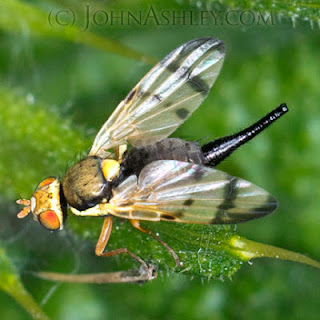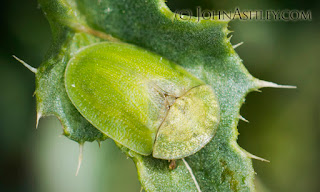"Why did John mow all the grass but not the thistle?" he asked. "Butterfly habitat," my wife answered. "Ohhhhhh." That explained one of my odd behaviors.
Earlier this summer summer, I started counting the different animals found on one small thistle plant. I quickly racked up a more than a dozen species of spiders, flies and beetles - and the ants, aphids and butterflies weren't even around yet. It struck me, this plant is a little "Thistle Universe." How could I mow it down?
I didn't recognize many of these little "bugs," so I submitted photos to BugGuide.net for expert identification. The results were a big surprise - the first three insects were all non-native, alien species. One fly and two beetle species native to Europe were already living in our neighborhood, with histories much more intriguing than my own.
 |
| Female Bull Thistle Gall Fly |
The colorful, 1/4" Bull Thistle Gall Fly (Urophora stylata) is a small fruit fly that lays its eggs in - you guessed it - Bull Thistle (Cirsium vulgare). Two to 30 larvae form a walnut-sized gall in developing seed heads, and their presence can reduce thistle seed production by 60%.
For biological weed control, BTGFs from Europe were introduced to British Columbia in 1973 and Quebec in 1976. Since then, many states have introduced BTGF as a host-specific biological agent to control this non-native thistle: Washington (1983), Colorado (1985), Oregon (1988), Montana (1989) and California (1993). In some areas, BTGF larvae now exist in 60-90% of the bull thistle seed heads.
Each June, adult BTGFs pupate from last year's thistle seed heads, but these adults will only live for two months. After mating, the females lay their eggs on this year's seed heads. The larvae hatch a week later, burrow into the seed-producing tissue, and induce the thistle plant to grow a gall. The larvae overwinter in this gall, and they'll emerge as adults next June.
Thistle-head Weevil (THW)
The accidental introduction of 10 Eurasian thistle species to N. America had become an agronomic problem by the mid-1950's. So the Canadian and U.S. departments of agriculture studied these thistles in France from 1961-66, and they identified more than 120 thistle-associated insect species. They chose the Thistle-head Weevil (Rhinocyllus conicus) as having a high potential for use as a biological control against the non-native thistles in N. America.
 |
| Two Thistle-head Weevils in combat on a thistle stalk |
After some field testing, these 1/4" green and black beetles were released in two Canadian provinces (1968) and four U.S. states (1969), including the Gallatin Valley in south-central Montana. Initial results looked good. After five years, the Gallatin Valley weevils had expanded over almost 800 square miles, and seed head production was reduced in some exotic thistles.
But contrary reports slowly began to surface. In several locations, these THWs developed a taste for some of our native thistles, which were already controlled by native insects and were not considered a problem. By 1976, 41% of the native Wavyleaf Thistle (Cirsium undulatum) examined in Montana had eggs from the imported weevils, and their larvae were found in 16% of the seed heads.
By 1985, researchers had found THW larvae in the seed heads of 17 native thistle species, including four rare species. In Nebraska, it was 20 years after the initial releases before the weevils switched from eating exotic thistles to native thistles. As the weevil population grew exponentially, and the native thistle populations shrank, the number of thistle-associated native insects also dropped dramatically in some locations.
In spite of the detrimental effects on native thistles and insects, the non-native Thistle-head Weevil is still promoted as an acceptable biological control of non-native thistles. Adult weevils are sold commercially, and hundreds of additional releases have occurred across the U.S.
Thistle Tortoise Beetle (TTB)
 |
| Adult Thistle Tortoise Beetle (click to see her foot) |
Like some of its little neighbors on my thistle plant, the TTB hails from Europe and has been introduced to N. America to control exotic thistles. But unlike the weevil, our native insects keep TTB populations from building up to damaging levels.
The adult TTB is a leaf beetle that looks sort of like a 1/4" tiny turtle. Accidentally introduced from the Mediterranean, it was first discovered in N. America in Quebec in 1902. It slowly spread east and west in Canada, and southwards into the U.S.
After arriving on its own, TTBs were purposely introduced to Virginia as a biological control for Musk Thistle (Carduus nutans) in 1969 (along with the Thistle-head Weevil). But they soon discovered that TTBs also had a taste for a number of native thistles, and the species is no longer approved for use in biological control. Still, they persist in low numbers across the northern U.S. - including the exotic thistle islands in my Montana yard.
The turtle-like adults overwinter in the soil, emerging in spring to mate and lay clumps of eggs on the underside of thistle leaves. The protective female lovingly covers her eggs with a layer of excrement. This is where the unsanitary association between excrement and young TTBs begins.
TTB eggs hatch into larvae that are best described as tiny, spiny, oval-shaped dragons. The lateral spines are augmented with a larger caudal fork that points upwards. The larvae go through five moults ("instars"), and after each moult, the dead skin is collected on the fork and held over the body as a shield from predators. As if the spines, forks and dead skin aren't deterrent enough, the TTBs also collect their excrement in this dead skin shield.
The Thistle Tortoise Beetle's shield has fascinated Naturalists since the early 1700's, and they have come up with many names for it. The names include "stercoraceous parasol" from 1869 (rough translation, "poop vomit umbrella"), "faeces pack" (1915), and "frass mask" (1935). The current name for this unusual structure is "fecal shield," from 1967.
 |
| Larval Thistle Tortoise Beetles with fecal shield (right) and without (left) |
Maybe my older, more utilitarian neighbors would appreciate what these three exotic insect species do "for work," helping to keep non-native thistles in check. People appreciate history more as they age, so maybe the neighbors would like to learn about the historical "man-vs-nature battles" that brought these creatures to their neighborhood. And just maybe, when my neighbors were younger, the odd behaviors of these insect residents would have caught their fancy.
Maybe, but probably not. Poop-covered bugs - like artists - aren't always easy to understand.

